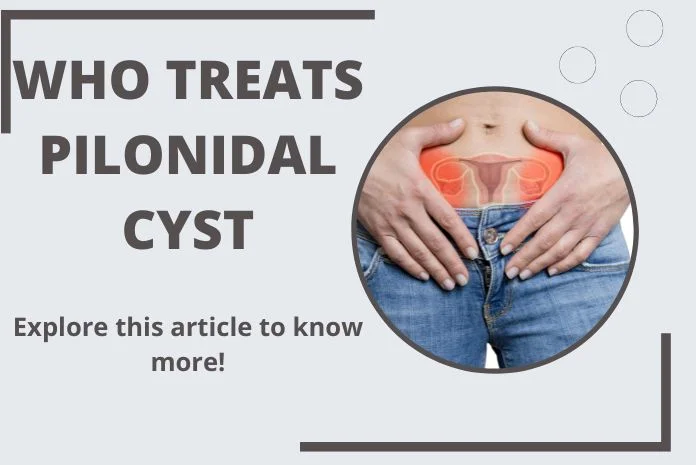A pilonidal cyst is a fluid-filled (usually pus) pocket in the skin of the natal cleft. The natal cleft is another name for the buttock crease. Apart from pus, the cyst also contains skin and hair debris. So, who treats pilonidal cyst? Let’s find out.
How susceptible are you to the condition?
According to the statistics, pilonidal cyst more commonly develops in obese and hairy men. They also either have a sedentary lifestyle or their jobs involve long hours of sitting. Let us see the pathology of the disease to understand these statistics.
How does one develop a pilonidal cyst?
The disease begins after the hair from the region is forced into the skin because of tight dressing and constant friction. The hair behaves as a foreign body inside the skin and evokes an inflammatory response. When infected, it leads to pus collection and the formation of a cyst. Tackling the cyst may cause the oozing of this pus.
On the other hand, the congenital form of pilonidal cyst begins from an already existing defect from birth. At times, this defect accumulates bacteria which leads to acute infection.
How does a pilonidal cyst present itself?
The cyst develops anywhere in the buttock crease, that is, the area extending from the tailbone to the anus.
A pilonidal cyst, in basic terms, may simulate a pimple in the cleft of the buttock. If you can look at it, it appears as a red swelling filled with yellowish pus and is tender to touch. The patient additionally experiences immense pain, especially upon sitting or laying on the back. They may also develop fever, as seen in cases of bacterial infection.
When should you seek help?
Unfortunately, a pilonidal cyst does not go away on its own. All cases have to be surgically treated, one day or the other. All the non-surgical treatments, such as warm compress, antibiotics, pain medication, etc., will only alleviate the pain and inflammation to some extent. The cavity won’t disappear on its own. Hence surgical intervention is the definitive management. Moreover, if you delay the operation more and more, it will convert into a chronic pilonidal sinus which has a poor prognosis even after surgery. So go ahead and seek help from a doctor who treats pilonidal cyst.
Are any investigations needed for confirmation?
Usually, pilonidal cysts are a clinical diagnosis. If there is a pimple-like pus-filled swelling in the gluteal cleft that is warm and tender, it is most likely to be a pilonidal cyst. Doctors come to this easy diagnosis just after a brief history taking and careful inspection.
However, in case there is some possibility of an alternate diagnosis, they might order a couple of tests. They may make use of an imaging modality like sonography or MRI to make sure of the disease they are dealing with. This helps them differentiate pilonidal cysts from other similar conditions like a pilonidal abscess, hidradenitis suppurativa, epidural abscess, and anal fistulas. It is essential to distinguish anal fistulas as they may point out a more dangerous internal pathology such as Crohn’s disease or ulcerative colitis.
Who treats pilonidal cysts?
In most cases, the first doctor a patient with a pilonidal cyst goes to is the general physician. The problem being a surgical one, the physician will soon refer you to a general surgeon. General surgeons treat pilonidal cysts in a lot of hospitals. However, they aren’t the best option in the market. Colorectal surgeons handle cases of pilonidal disease and a variety of other pathologies of the large bowel. They have undergone additional training in colorectal surgery after their general surgery residency. Hence an experienced colorectal surgeon is the best doctor who treats pilonidal cysts.
What surgery is done for a pilonidal cyst?
There are two commonly done procedures for pilonidal cyst: Incision and drainage and pilonidal cystectomy. The procedure of incision and drainage is exactly what it sounds like. It is a daycare surgery with minimal handling and fast recovery. It involves draining out the pus and debris collected inside the cyst by puncturing the wall using sterile surgical needles. The cavity isn’t sutured back close again. Instead, it is left open to allow easy drainage of any future collection. The cavity is packed with antiseptic-soaked gauze pieces, which must be periodically replaced. The wound heals and dries up in a month.
Moving on to the second procedure, pilonidal cystectomy, which is the definitive treatment of pilonidal disease. This procedure is directed at the complete removal of the cyst and surrounding tissues, unlike in incision and drainage. The cyst, along with the debris, underlying tissue, overlying skin, and all hair follicles around, are scraped off. As extensive as it sounds, it is not desirable to carry out the procedure using just local anesthesia. We must put the patient asleep by general anesthesia or at least numb the entire lower limb using spinal anesthesia. The recurrence following pilonidal cystectomy is extremely rare, though not impossible.
What to expect after the treatment?
The patient must maintain adequate personal hygiene along with weight reduction and mobility if indicated. This is to ensure no relapse post-surgery. We know that pilonidal cystectomy has a very low recurrence rate, but sometimes due to inadequate tissue demarcation, it becomes tricky to remove all of the diseased tissues.

